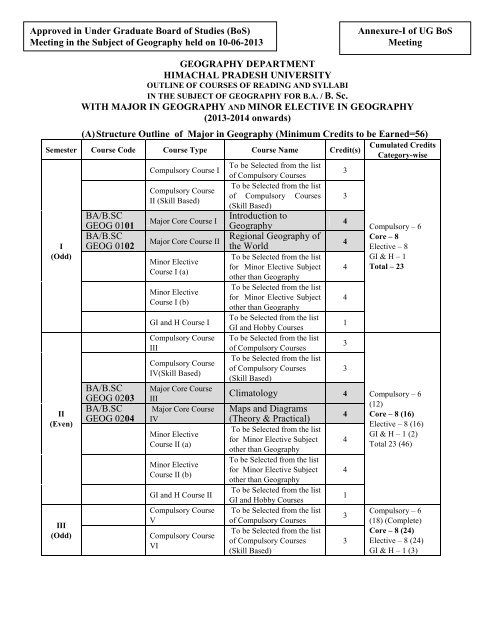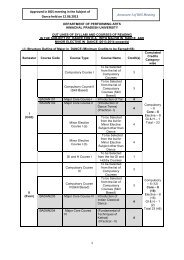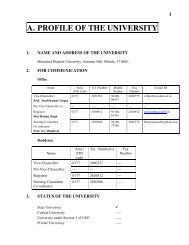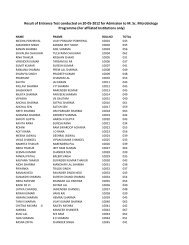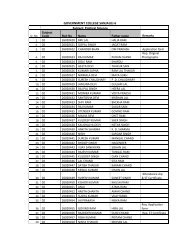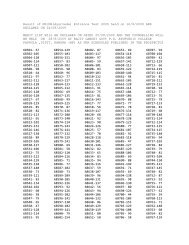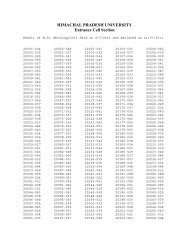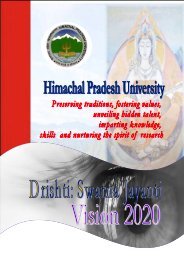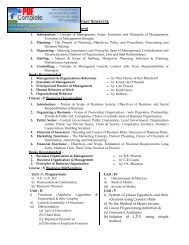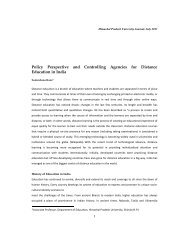Detailed Syllabus- Outline, End Term Exam Guidelines, Structure, etc.
Detailed Syllabus- Outline, End Term Exam Guidelines, Structure, etc.
Detailed Syllabus- Outline, End Term Exam Guidelines, Structure, etc.
Create successful ePaper yourself
Turn your PDF publications into a flip-book with our unique Google optimized e-Paper software.
Approved in Under Graduate Board of Studies (BoS) 1Meeting in the Subject of Geography held on 10-06-2013Annexure-I of UG BoSMeetingGEOGRAPHY DEPARTMENTHIMACHAL PRADESH UNIVERSITYOUTLINE OF COURSES OF READING AND SYLLABIIN THE SUBJECT OF GEOGRAPHY FOR B.A. / B. Sc.WITH MAJOR IN GEOGRAPHY AND MINOR ELECTIVE IN GEOGRAPHY(2013-2014 onwards)(A) <strong>Structure</strong> <strong>Outline</strong> of Major in Geography (Minimum Credits to be Earned=56)Semester Course Code Course Type Course Name Credit(s)I(Odd)II(Even)III(Odd)BA/B.SCGEOG 0101BA/B.SCGEOG 0102BA/B.SCGEOG 0203BA/B.SCGEOG 0204Compulsory Course ICompulsory CourseII (Skill Based)Major Core Course IMajor Core Course IIMinor ElectiveCourse I (a)Minor ElectiveCourse I (b)GI and H Course ICompulsory CourseIIICompulsory CourseIV(Skill Based)Major Core CourseIIIMajor Core CourseIVMinor ElectiveCourse II (a)Minor ElectiveCourse II (b)GI and H Course IICompulsory CourseVCompulsory CourseVITo be Selected from the listof Compulsory CoursesTo be Selected from the listof Compulsory Courses(Skill Based)Introduction toGeographyRegional Geography ofthe WorldTo be Selected from the listfor Minor Elective Subjectother than GeographyTo be Selected from the listfor Minor Elective Subjectother than GeographyTo be Selected from the listGI and Hobby CoursesTo be Selected from the listof Compulsory CoursesTo be Selected from the listof Compulsory Courses(Skill Based)Climatology 4Maps and Diagrams(Theory & Practical)4To be Selected from the listfor Minor Elective Subjectother than GeographyTo be Selected from the listfor Minor Elective Subjectother than GeographyTo be Selected from the listGI and Hobby CoursesTo be Selected from the listof Compulsory CoursesTo be Selected from the listof Compulsory Courses(Skill Based)33444413344133Cumulated CreditsCategory-wiseCompulsory – 6Core – 8Elective – 8GI & H – 1Total – 23Compulsory – 6(12)Core – 8 (16)Elective – 8 (16)GI & H – 1 (2)Total 23 (46)Compulsory – 6(18) (Complete)Core – 8 (24)Elective – 8 (24)GI & H – 1 (3)
3Semester Course Code Course Type Course Name Credit(s)BA/B.SCGEOG 0614Major Core CourseXIVCore / ElectiveCourse (Additional)*Core / ElectiveCourse (Additional)*Core / ElectiveCourse (Additional)*Core / ElectiveCourse (Additional)*Core / ElectiveCourse (Additional)*Resource Geography 4Any one of the Additionalor open elective coursesAny one of the Additionalor open elective coursesAny one of the Additionalor open elective coursesAny one of the Additionalor open elective coursesAny one of the Additionalor open elective courses44444Cumulated CreditsCategory-wise
5Compulsory and General Interest / Hobby Courses Offered by Geography DepartmentSemester Course Code Course Type Course Name(Odd)BA/B.SC GEOG0512 CompulsoryGeography of HimachalPradeshCredit(s)3CumulatedCreditsC(Even)BA/B.SC GEOG4489GIGeography of India (ForCompetitive <strong>Exam</strong>inations)3(Odd)BA/B.SC GEOG0100 GI / HThe World: MapAppreciation2
6(B) <strong>Structure</strong> <strong>Outline</strong> of Minor Elective in Geography for other than MajorGeography Students (Minimum Credits to be Earned=20)Semester Course Code Course Name Course Name Credit(s)I(Odd)II(Even)III(Odd)BA/B.SCGEOG0101/0102BA/B.SCGEOG0203/0204BA/B.SCGEOG0305/0306CompulsoryCourse ICompulsoryCourse II (SkillBased)Major CoreCourse IMajor CoreCourse IIMinor ElectiveCourse I (a)Minor ElectiveCourse I (b)GI and H CourseICompulsoryCourse IIICompulsoryCourse IV(SkillBased)Major CoreCourse IIIMajor CoreCourse IV OpticsMinor ElectiveCourse II (a)Minor ElectiveCourse II (b)GI and H CourseIICompulsoryCourse VCompulsoryCourse VIMajor CoreCourse VMajor CoreCourse VIMinor ElectiveCourse III (a)Introduction toGeography / RegionalGeography of theWorldClimatology / Mapsand Diagrams (Theory& Practical)33444413344441334------ 4The Earth: Origin,Evolution and<strong>Structure</strong> / Elementsof Geomorphology4CumulatedCreditsCategorywiseCompulsory– 6Core – 8MinorElective 1(a)– 4(4)MinorElective1(b)=4Total MinorElectives – 8(8)GI & H – 1Total – 23Compulsory– 6 (12)Core – 8 (16)MinorElective1I(a) – 4 (8)MinorElective 1I(b)– 4 (8)Total MinorElectives – 8(16)GI & H – 1(2)Total 23 (46)Compulsory– 6 (18)(Complete)Core – 8 (24)MinorElectiveIII(a) – 4(12)MinorElectiveIII(b) – 4 (12)Elective – 8
7Semester Course Code Course Name Course Name Credit(s)IV(Even)BA/B.SCGEOG0407/0408/0409GI and H CourseIIIMajor CoreCourse VIIMajor CoreCourse VIIIMajor CoreCourse IXMinor ElectiveCourse IV (a)Minor ElectiveCourse IV (b)Core / ElectiveCourse------ 1------ 4------ 4------ 4Oceanography/Physical Geography ofIndia/ HumanGeography of India------ 4------ 44CumulatedCreditsCategorywise(24)GI & H – 1(3)(Complete)Total 23 (69)Core – 12(36)MinorElectiveIV(a) – 4(16)MinorElectiveIV(b) – 4 (16)Total MinorElectives – 8(32)Core /Elective(additional) -4Total 24 (93)V(Odd)Major CoreCourse XMajor CoreCourse XIMajor CoreCourse XIIBA/B.SCGEOG0510/0511/0512 Minor ElectiveCourse V(a)Minor ElectiveCourse V(b)Core / ElectiveCourse(Additional)*------ 4------ 4------ 4Principles of HumanGeography/ MapProjections /ComprehensiveGeography ofHimachal Pradesh------ 4Population Geography/EnvironmentalGeography44Core – 12(48)MinorElective V(a)– 4 (20)MinorElective V(b)– 4 (20)Total MinorElectives – 8(40)(Complete)Core /Elective(additional) -4Total 24(117)VI(Even)Major CoreCourse XIIIMajor CoreCourse XIV------ 4------ 4Core – 8 (56)Core /Elective(additional) –
8Semester Course Code Course Name Course Name Credit(s)Core / ElectiveCourse(Additional)*Core / ElectiveCourse(Additional)*Core / ElectiveCourse(Additional)*Core / ElectiveCourse(Additional)*Core / ElectiveCourse(Additional)*FieldSurvey(Physical/Socio-Economic) andPreparation of ProjectReportResource Geography 4Economic Geography/Fundamentals ofRemote SensingRegional Geography ofIndia/ Fundamentals ofGISSocial Geography/Evolution ofGeographical Thought4444CumulatedCreditsCategorywise20*Total 28(145)
9OUTLINE OF SYLLABI AND COURSES OF READINGIN THE SUBJECT OF GEOGRAPHY FOR B.A. / B. Sc.WITH MAJOR IN GEOGRAPHY AND MINOR ELECTIVE IN GEOGRAPHY(2013-2014 onwards)COURSE: INTRODUCTION TO GEOGRAPHY (0101)Course Code BA/B.SC GEOG 0101Credits-4 L T P31 14 30*(15)Course TypeCore: Major & MinorLectures to be Delivered 60Course Objective: The purpose of this course is to introduce students to the basic understanding aboutGeography and its emergence as a branch of knowledge. It also aims to teach the students about thegeometry of earth, core themes in the subject of Geography and role of skills in Geography.Continuous Comprehensive Assessment (CCA) Pattern: Maximum Marks Allotted: 50Minor Test* (Marks) Class Test/Quiz/Seminars Attendance Total MarksTutorials/Assignments(Marks)(Marks) (Marks)Test -I 15 10 5 5Test - II 1550Total 30 10 5 5* The pattern of examination for conducting the minor test will be same as prescribed for the endsemester examination.<strong>End</strong> Semester <strong>Exam</strong>ination System: Maximum Marks Allotted: 50Components Maximum Marks Minimum Pass Marks Time AllottedAllottedTheory 35 16 3.00 HrsPractical 15 7 3.00 HrsTotal 50 23 6.00 HrsPaper Setting Scheme (Theory Paper)Section No of <strong>Syllabus</strong> Nature of Questions and Answers Questions to be MaximumQuestions CoverageAttemptedMarksA 10 Complete Objective Type 10(0.5 mark each) 5B 5 Complete Short answer type (25 words) 5(1.5 marks each) 7.5C 10 Complete Medium answer type (50 words) 5(2.5 marks each) 12.5D 3 Complete Long answer type (1000 words) 1(10 marks each) 10Total 35Note: Use of non-programmable calculators and map stencils are allowed in the examination hall.Marks Allocation Scheme (Practical Paper)ParticularsMaximum MarksPractical Record* 7Written/Lab Work 5Viva-Voce 3Total 15Note: Use of non-programmable calculators and map stencils are allowed in the examination hall.* The practical record may be evaluated on the parameters of Punctuality, Neatness, Entirety andIndexing.
10Course Content and Credit SchemeUnit TopicI. DEFINING THE FIELDI. MeaningII. NatureIII. ScopeIV. RelevanceV. A Brief Introduction to Emergence of Geography as aScientific DisciplineII. BASICS IN GEOGRAPHYI. Motions of Eartha. Rotation and Revolution of Earth and Their Effectsb. Time Zones & International Date LineII. Dimension of Eartha. Shape & Sizeb. Geoid, Spheroid and EllipsoidIII. Concept of Coordinate Systema. Geographic Coordinate System of EarthAllotted Time HoursL T P10 4 010 5III.IV.GEOGRAPHY’S CORE CONCEPTS/ FIVE MAJOR THEMESI. Locationa. Absoluteb. RelativeII. Place/ Spacea. Physical Characteristicsb. Human CharacteristicsIII. Human-Environment Interactiona. Dependenceb. Modificationc. AdaptationIV. Movementsa. Humanb. Informationc. IdeaV. Regionsa. Typesi. Formalii. Functionaliii. VernacularVI. A Neighbourhood Project on any one ThemeBASIC SKILLS IN GEOGRAPHYI. Map as a Tool of GeographerII. Instrumental Surveys6 4 10(5)5 1 20(10)
11a. Plane Table: Open & Traverse Methodb. Prismatic Compass: Open & Traverse MethodIII. Cartographya. Traditionalb. Computer-assistedIV. Remote Sensing (RS)a. Meaning , Concept and Types of RSb. Electromagnetic SpectrumV. Geographic Information System (GIS)a. Meaning, Components and Importance of GISTotal Hours 31 14 30* (15)L-Lecture, T-Tutorial and P-Practical and Practices* As per the weightage assigned to the P (Practical and Practices) category in the CBCSregulations 2 hours practical work has been treated equal to 1 credit. Therefore, in this coursepaper, the laboratory/ field work and preparation of practical record for additional 15 hours overand above prescribed 60hours limit will be completed during either on Friday/Saturday of a week(@ 1hour/day for 15 days).Text Book(s):Jordan T. G. and Rowntree L. 1999. The Human Mosaic: A Thematic Introduction to CulturalGeography. (8th ed.). Addison Wesley Longman Publishers, New York.Suggested Readings:Stoddart, R.H. Wishart, D.J. and Blouct, B.W. 1989. Human Geography: People, Places andCultures. Prentice Hall, New Jersey.Wagner, P.L. and Mikesell, M.W. 1962. Readings in Cultural Geography. The University ofChicago Press, Chicago.Phillip C. Muehrcke. 1978. Map Use: Reading Analysis and Interpretation. JP Publications,Madison, WI.John Campbell. 1991. Map Use and Analysis. Wm. C. Brown Publishers, Dubuque, IndianaUSA.COURSE: REGIONAL GEOGRAPHY OF THE WORLD (0102)Course Code BA/B.SC GEOG 0102Credits-4 L T P31 14 30 (15)Course TypeCore: Major & MinorLectures to be Delivered 60Course Objective: The purpose of this course is to introduce the students about theconceptualization of region, components of regions and bases of regionalization. It is alsointended to provide the basic knowledge about the major climatic regions of the world.Continuous Comprehensive Assessment (CCA) and <strong>End</strong> Semester <strong>Exam</strong>ination System: Sameas Prescribed in Course 0101
12Course Content and Credit SchemeUnit Topic Allotted Time(Hours)L T PI. INTRODUCTION TO REGIONAL GEOGRAPHY7 2 0i. Region – Definitionii. Methods of Delineation of Regions – Formal And FunctionalRegionsiii. Natural components of regionsa. Landforms: Types and Distributionb. Climate: Types and Distributionc. Soils: Types and Distributiond. Natural Vegetation: Types and Distributioniv. Bases of RegionalizationII. HOT REGIONS8 4 0(Location and Characteristic Features)a. Equatorial Regioni. Highland and Lowland Regionsb. Tropical Region;i. Monsoon Regionii. Tropical Grasslandiii. Tropical DesertsIII. WARM TEMPERATE REGIONS8 4 0(Location and Characteristic Features)i. Warm Temperate Regionsa. Mediterraneanb. Temperate Grasslandsc. China typeIV. COOL TEMPERATE & POLAR REGIONS8 4 30(15)*(Location and Characteristic Features)i. Cool Temperate Regions:a. British Type or Marine West coastsb. Siberian Typec. Laurentian Typeii. Polar Regionsa. Highland or Ice cap Typeb. Lowland or Tundra Typeiii. Project on any One RegionTotal Hours 31 14 30(15)*L-Lecture, T-Tutorial and P-Practical and Practices*As per the weightage assigned to the P (Practical and Practices) category in the CBCSregulations 2 hours practical work has been treated equal to 1 credit. Therefore, in this coursepaper, the laboratory/ field work and preparation of practical/project record/report for additional
1315 hours over and above prescribed 60hours limit will be completed during either onFriday/Saturday of a week (@ 1hour/day for 15 days).Text Book(s):Heintzelman O.H., Richard et al.1965. World Regional Geography. Prentice Hall of India (P)Ltd. New Delhi.Suggested Readings:Tikha,R.N., Bali, P.K. and Sekhon, M.S. 2010. World Regional Geography. New AcademicPublishing Company, New Delhi.Minshull R.1967. Regional Geography: Theory and Practice. Hutchinson University Library,London.COURSE: CLIMATOLOGY (0203)Course Code BA/B.SC GEOG 0203Credits-4 L T P40 20 0Course TypeCore: Major & MinorLectures to be Delivered 60Course Objective: This course is intended to provide the students an understanding about thedifferent elements of climate and the underlying processes in their operations.Continuous Comprehensive Assessment (CCA) Pattern: Maximum Marks Allotted: 50Minor Test* (Marks) Class Test/Quiz/Seminars Attendance Total MarksTutorials/Assignments(Marks)(Marks) (Marks)Test -I 15 10 5 5Test - II 1550Total 30 10 5 5* The pattern of examination for conducting the minor test will be same as prescribed for the endsemester examination.<strong>End</strong> Semester <strong>Exam</strong>ination System: Maximum Marks Allotted: 50Maximum Marks Allotted Minimum Pass Marks Time Allotted50 23 3.00 HrsPaper Setting SchemeSection No of Questions <strong>Syllabus</strong> Nature of Questions Questions to MaximumCoverage and Answersbe Attempted MarksA 10 (1 mark each) Complete Objective Type 10 10B 5(2 marks each) Complete Short answer type5 10(25 words)C 10(3 marks each) Complete Medium answer type (50 5 15words)D 3(15 marks each) Complete Long answer type (1000 1 15words)Note: Use of non-programmable calculators and map stencils are allowed in the examination hall.
14Course Content and Credit SchemeUnit Topic Allotted Time(Hours)L T PI. Introduction11 6 0i. Meaning and Nature of Climatologyii. Composition & <strong>Structure</strong> of Atmosphereiii. Factors influencing distribution of Insolation andTemperature, Inversion of temperature and Heat BudgetII. Atmospheric Pressure & Wind System10 5 0I. Horizontal and Vertical Distribution of PressureII. Pressure and Wind SystemIII. Seasonal and Local WindsIII. Atmospheric Moisture10 5 0I. Processes of evaporation, Types of Humidity andHydrological CycleII. Condensation and its Types, Clouds and Their TypesIII. Rainfall and its TypesIV. Airmass and Atmospheric Disturbances9 4 0I. Airmass: Meaning, Characteristics, Source Region andClassification and ModificationII. Atmospheric disturbances: Cyclones: Temperate andTropicalTotal Hours 40 20 0L-Lecture, T-Tutorial and P-Practical and PracticesText Book(s):Trewartha, G. T. 1968. An Introduction to Climate. McGraw-Hill Book Company, NewYork.D.S. Lal. 1998. Climatology. Chaitanya Publishing House, Allahabad.Suggested Readings:Critchfield, J. Howard. 2012. General Climatology. 4 th Edition (Reprinted). Phi Learning Pvt.Ltd., New Delhi.Das, P. K. 2011. The Monsoons. National Book Trust, New DelhiCOURSE: MAPS AND DIAGRAMS (THEORY AND PRACTICAL) (0204)Course Code BA/B.SC GEOG 0204Credits-4 L T P20 10 60*(30)Course TypeCore: Major & MinorLectures to be Delivered 60Course Objective: The purpose of this course is to introduce students to some of the basicconcepts in the preparation of maps and diagrams and their appreciation in Geography.
15Continuous Comprehensive Assessment (CCA) Pattern: Maximum Marks Allotted: 50Minor Test* (Marks) Class Test/Quiz/Seminars Attendance Total MarksTutorials/Assignments(Marks)(Marks) (Marks)Test -I 15 10 5 5Test - II 1550Total 30 10 5 5* The pattern of examination for conducting the minor test will be same as prescribed for the endsemester examination.<strong>End</strong> Semester <strong>Exam</strong>ination System:Components Maximum Marks Minimum Pass Time AllottedAllottedMarksTheory 25 11.50 3.00 HrsPractical 25 11.50 3.00 HrsTotal 50 23 6.00 HrsPaper Setting Scheme (Theory Paper)Section No of <strong>Syllabus</strong> Nature of Questions and Questions to be MaximumQuestions Coverage AnswersAttempted MarksA 10 Complete Objective Type 10(0.5 mark each) 5B 5 Complete Short answer type (25 words) 5(1 marks each) 5C 10 Complete Medium answer type (50 words) 5(1.5 marks each) 7.5D 3 Complete Long answer type (1000 words) 1(10 marks each) 7.5Total 25Marks Allocation Scheme (Practical Paper)ParticularsMaximum MarksPractical Record* 10Written/Lab Work 10Viva-Voce 5Total 25Note: Use of non-programmable calculators and map stencils are allowed in the examination hall.* The practical record may be evaluated on the parameters of Punctuality, Neatness, Entirety andIndexing.Course Content and Credit SchemeUnit Topic Allotted Time HoursL T PI. CARTOGRAPHY5 2 12* (6)I. Cartography as a Science of Communication andBasics of Map ReadingII.III.Scale- Definition, Importance and Types of ScaleMaps- Definition, Classification and Significance ofMaps
16II.III.REPRESENTATION OF RELIEF FEATURESI. Methods of representing Relief- Qualitative andQuantitativeII. Profiles: Definition and TypesTOPOGRAPHICAL MAPSI. History of Topographical Maps in IndiaII. Importance of Topographical Maps and Extraction ofInformation From Topographical SheetsIII. Open Series Maps(OSM) and Their Sequencing5 2 12* (6)5 3 12* (6)IV.REPRESENTATION OF DATAI. Different Types of Data, Scales of Measurement:Nominal, Ordinal, Interval and RatioII. Methods of Representing Data: Line Graph, ColumnarDiagrams, Isopleth and Choropleth Maps, Dot Method,5 3 24*(12)Climograph and HythergraphTotal Hours 20 10 60*(30)L-Lecture, T-Tutorial and P-Practical and Practices* As per the weightage assigned to the P (Practical and Practices) category in the CBCSregulations 2 hours practical work has been treated equal to 1 credit hour. Therefore, in thiscourse paper, the laboratory work and preparation of practical record file for additional 30hoursover and above prescribed 60hours limit will be completed during either on Friday and /Saturday of a week (@ 1hour/day for 30days).Text Book(s):Singh, R.L and Rana, P.B. 2002. Elements of Practical Geography. Kalayani Publishers, NewDelhi.Suggested Readings:Khullar, D.R. 2000. Essentials of Practical Geography. New Academic Publishing Company,Jallandhar.Menno-JanKraak and Ferjan Ormeling(2005) Cartography- Visulaization of Geospatial Data (2 ndEdition) Pearson Publication.COURSE: THE EARTH: ORIGIN, EVOLUTION AND STRUCTURE (0305)Course Code BA/B.SC GEOG 0305Credits-4 L T P31 14 30 (15)*Course TypeCore: Major & MinorLectures to be Delivered 60Course Objective: The purpose of this course is to introduce students as to how the Earth hascome into existence, what material it is made up of and how does it behave?Continuous Comprehensive Assessment (CCA) and <strong>End</strong> Semester <strong>Exam</strong>ination System: Sameas Prescribed in Course 0101Course Content and Credit SchemeUnit Topic Allotted Time HoursL T P
17I. BASIC CONCEPTS9 4 0I. Brief Introduction to Solar System, Origin of Earth:Tidal Theory of Jeans and Jeffreys; and Big BangTheoryII. Rocks: Classification and Their CharacteristicsIII. Internal <strong>Structure</strong> of the EarthII. I. EARTH MOVEMENTS7 4 0II. <strong>End</strong>ogenetic forces: Orogenetic and EpeirogeneticForcesIII. Types of Folds And FaultsIV. Sliding Continent Theory of Mountain Building by DalyIII. ORIGIN OF CONTINENTS AND OCEAN BASINS- 8 3 0SOME VIEWSI. Isostasy- Airy and Pratt’s conceptsII. Wegener’s Theory of Continental DriftIII. Plate Tectonic TheoryIV. SUDDEN FORCES7 3 30 (15)*I. Volcanoes: Components, Classification, Causes andWorld Distribution of VolcanoesII. Earthquakes: Concept and Causes of Earthquakes,Distribution and Effects of EarthquakesIII. Project on Any Selected Theme of the Entire CourseTotal Hours 31 14 30 (15)*L-Lecture, T-Tutorial and P-Practical and Practices* As per the weightage assigned to the P (Practical and Practices) category in the CBCSregulations 2 hours practical work has been treated equal to 1 credit hour. Therefore, in thiscourse paper, the laboratory work and preparation of practical record file for additional 15 hoursover and above prescribed 60hours limit will be completed during either on Friday and /Saturday of a week (@ 1hour/day for 15 days).Text Book(s):Singh, Savindra. 2000. Geomorphology. Prayag Pustak Bhawan, Allahabad.Suggested Readings:Dayal, P. 2010. A Text Book of Geomorphology. Rajesh Publishers, New DelhiCOURSE: ELEMENTS OF GEOMORPHOLOGY (0306)Course Code BA/B.SC GEOG 0306Credits-4 L T P31 14 30 (15)*Course TypeCore: Major & MinorLectures to be Delivered 60Course Objective: The purpose of this course is to introduce the students to some of the basicconcepts about the nature and formation of different types of landforms covering the earthsurface.Continuous Comprehensive Assessment (CCA) and <strong>End</strong> Semester <strong>Exam</strong>ination System: Sameas Prescribed in Course 0101
18Course Content and Credit SchemeUnit Topic Allotted Time HoursL T PI. INTRODUCTION9 4 0I. 1.Meaning, Nature and Scope of GeomorphologyII. 2. Weathering and Mass Movements: Meanings, FactorsAffecting and TypesII. DRAINAGE PATTERNS AND FLUVIAL LANDSCAPE 7 4 0I. Meaning and Types Of Drainage PatternsII. Erosional and Depositional Work and Landforms ofRiverIII. Normal Cycle of ErosionIII. GLACIAL AND ARID LANDFORMS8 3 0I. Types of Glaciers, Erosional and Depositional Workand Landforms of GlaciersII. Erosional and Depositional Work of Wind andLandforms of Arid EnvironmentIV. KARST AND COASTAL LANDFORMS7 3 30 (15)*I. Meaning and Components of Groundwater,Erosional and Depositional LandformsII. Processes of Marine Erosion, Erosional andDepositional LandformsIII. Project on Any Selected Theme of the Entire CourseTotal Hours 31 14 30 (15)*L-Lecture, T-Tutorial and P-Practical and Practices* As per the weightage assigned to the P (Practical and Practices) category in the CBCSregulations 2 hours practical work has been treated equal to 1 credit hour. Therefore, in thiscourse paper, the laboratory work and preparation of practical record file for additional 15 hoursover and above prescribed 60hours limit will be completed during either on Friday and /Saturday of a week (@ 1hour/day for 15 days).Text Book(s):Singh, Savindra (2000). Geomorphology. Prayag Pustak BhawanSuggested Books/Readings:Dayal, P. 2010. A Text Book of Geomorphology. 3 rd Edition. Rajesh Publishers, New DelhiKale, V. S. 2010. Introduction to Geomorphology. Orient Blackswan, Hyderabad, Andhra PradeshCOURSE: OCEANOGRAPHY (0407)Course Code BA/B.SC GEOG 0407Credits-4 L T P46 14 0Course TypeCore: Major & MinorLectures to be Delivered 60Course Objective: The purpose of this course is to introduce the students about thefundamentals of oceanography. By the end of the course, a student will have a clear
19understanding about the origin of oceans, configuration, oceanic water properties and theirimportance to mankind.Continuous Comprehensive Assessment (CCA) and <strong>End</strong> Semester <strong>Exam</strong>ination System:Same as Prescribed in Course Paper 0203Course Content and Credit SchemeUnit Topic Allotted Time(Hours)L T PI. Introduction to Oceanography and Relief of the Ocean 9Floor4 0I. Meaning, Scope and Importance ofOceanographyII.III.Global Water BudgetConfiguration of Pacific and Indian OceanFloorsII.III.IV.Characteristics of Ocean WaterI. Composition of Ocean WaterII.Temperature in the Oceansa. Factors Affecting Distribution ofTemperatureb. Horizontal and Vertical DistributionIII.Salinity in the oceansa. Factors Controlling Salinityb. Horizontal and Vertical DistributionIV.Density in the Oceansa. Factors Controlling Densityb. Horizontal and Vertical DistributionMovement of Oceanic WaterI. Waves and Tidesa. Waves, Their <strong>Structure</strong>, Kindsb. Wave Generated Currents,Catastrophic WavesII.Tidesa. Origin and Types of Tidesb. Effects of TidesIII.Oceanic Currentsa. Origin and Typesb. Currents of Pacific, Atlantic andIndian OceanOcean Deposits, Coral Landforms and Man and OceanI. Ocean Depositsa. Sources and Kinds of MarineDeposits12 4 012 3 013 3 0
20II.III.b. Horizontal and Vertical DistributionCoral Reefsa. Conditions for Coral Growthb. Types of Coral Landformsc. Zonation and DistributionMan and Oceansa. Oceans and Climateb. Food supply from OceansTotal Hours 46 14 0L-Lecture, T-Tutorial and P-Practical and PracticesText Book(s): Sharma, R.C. and Vatal, M. 2011. Oceanography for Geographers. Reprinted,Chaitanya Publishing House, New Delhi.Suggested Readings:Gautam, Alka. 2004. Climatology and Oceanography. Rastogi Publication-Meerut, UP.Singh, Savindera. 2009. Physical Geography. Vasundhra Publications, Gorkhpur, UP.COURSE: PHYSICAL GEOGRAPHY OF INDIA (0408)Course Code BA/B.SC GEOG 0408Credits-4 L T P44 16 0Course TypeCore: Major & MinorLectures to be Delivered 60Course Objective: The purpose of this course is to introduce the physical aspects of IndianGeography to the students. By the end of the course student will have a clear understandingabout the location, physical divisions, drainage system, climate, soils, vegetation and hazardsaffecting Indian Territory.Continuous Comprehensive Assessment (CCA) and <strong>End</strong> Semester <strong>Exam</strong>ination System: Sameas Prescribed in Course Paper 0203Course Content and Credit SchemeUnit Topic Allotted Time(Hours)L T PI. A GEOGRAPHIC BACKGROUND11 4 0I. Introductioni. Geographical Locationii. Unity in Diversityiii. Geostrategic ImportanceII. Physiographic Divisions of Indiai. Northern Mountainsii. Great Plainsiii. Peninsular Plateauiv. Coastal Plains and IslandsII. DRAINAGE AND CLIMATE11 4 0I. Drainage System of Indiai. Major Drainage Systems- Comparison betweenHimalayan and Peninsular River System
21III.ii. River Water Pollution and ConservationII. Climate of Indiai. Factors Affecting Climateii. Summer and Winter Monsooniii. Western Disturbancesiv. Spatial Pattern of Precipitationv. Climatic Classification by KoppenSOILS AND NATURAL VEGETATIONI. Soils of Indiai. Factors of Soil Formationii. Classification and Spatial Distributioniii. Degradation and ConservationII. Natural Vegetation of Indiai. Factors affecting distribution of vegetationii. Vegetation Types and Spatial Distributioniii. Depletion of Natural Vegetation and their Conservationiv. National Forest Policy and Social Forestry11 4 0IV. Hazards and their Mitigation11 4 0I. Meaning and Typei. Earthquakeii. Cyclonesiii. FloodsII. Mitigation StrategiesTotal Hours 44 16 0L-Lecture, T-Tutorial and P-Practical and PracticesText Book(s):Gautam, Alka. 2004. Geography of India. Rastogi Publication-Meerut, UP.Khullar, D.R. 2009. India: A Comprehensive Geography. Kalyani Publisher, New Delhi.Suggested Readings:Rao B.P. 2008. Bharat Ki Bhogolik Samiksha. Vasundhra Prakashan, GorkhpurSharma T.C. 2007. Economic and Commercial Geography of India. Vikas Publishing House,New Delhi.COURSE: HUMAN GEOGRAPHY OF INDIA (0409)Course Code BA/B.SC GEOG 0409Credits-4 L T P44 16 0Course TypeCore: Major & MinorLectures to be Delivered 60Course Objective: This course is intended to introduce the human aspects of Indian Geographyto the students. By the end of the course the student will have a clearer view of the spatialdistribution of human and economic resources in India.Continuous Comprehensive Assessment (CCA) and <strong>End</strong> Semester <strong>Exam</strong>ination System: Sameas Prescribed in Course Paper 0203Course Content and Credit Scheme
22Unit Topic Allotted Time(Hours)L T PI HUMAN RESOURCE11 4 0I. General Demographic SceneII. Growth of PopulationIII. Distribution and Density of PopulationIV. Literacy DifferentialsV. Sex CompositionVI. Population Problems and its Remedial MeasuresII Agricultural Scenario11 4 0I. Agriculturea. Major Features and Problemsb. Green Revolution and Its ImpactII. Food Cropsa. Wheatb. RiceIII. Cash Cropsa. Cottonb. TeaIII Mineral & Energy Resources11 4 0I. Metallic Minerals- Iron oreII. Non-Metallic Minerals- MicaIII. Conventional and Non Conventional Energy Resources-Coal, Petroleum Hydro-power and Nuclear EnergyIV Major Manufacturing Industries11 4 0I. Factors influencing the location of industriesII. Case study of Cotton, Iron and Steel and Paper IndustriesIII. Major Industrial Regions- Mumbai- Pune and Hugli-KolkataTotal Hours 44 16 0L-Lecture, T-Tutorial and P-Practical and PracticesText Book(s):Gautam, Alka. 2004. Geography of India. Rastogi Publication-Meerut, UP.Khullar, D.R. 2009. India: A Comprehensive Geography. Kalyani Publisher, New Delhi.Suggested Readings:Rao B.P. 2008. Bharat Ki Bhogolik Samiksha. Vasundhra Prakashan, GorkhpurSharma T.C. 2007. Economic and Commercial Geography of India. Vikas Publishing House,New Delhi.COURSE: PRINCIPLES OF HUMAN GEOGRAPHY (0510)Course Code BA/B.SC GEOG 0510Credits-4 L T P44 16 0Course TypeCore: Major & MinorLectures to be Delivered 60Pre-Requisite RequiredNone
23Course Objective: This course introduces the students to the fundamental principles of HumanGeography in its various facets such as population, settlements and residence <strong>etc</strong>.Continuous Comprehensive Assessment (CCA) and <strong>End</strong> Semester <strong>Exam</strong>ination System: Sameas Prescribed in Course Paper 0203Course Content and Credit SchemeUnit Topic Allotted Time(Hours)L T PI INTRODUCTION11 4 0i. Meaning, Nature and Scope of Human Geographyii. Basic Thoughts in Human Geography: Determinism andPossibilismII POPULATION11 4 0i. Spatial Distribution And Density of World Populationii. Factors Affecting The Distribution And Density ofWorld Populationiii. Malthusian Theory of Population Growth, DemographicTransition TheoryIII HUMAN SETTLEMENTS11 4 0i. Classification of Settlementsii. Function and Pattern of Rural SettlementsIV URBANISATION11 4 0i. Functional Classification of Towns, Basis of UrbanSettlementsii. Urbanization in India- Level, Trends and ProblemsTotal Hours 44 16 0L-Lecture, T-Tutorial and P-Practical and PracticesText Book(s):Husain, Majid. 2010. Human Geography. Repinted. Rawat Publications, Jaipur.Suggested Readings:Singh, R.L. 2012. Fundamentals of Human Geography. Sharda Publications, Varanasi, UP.Pitzl, Gerald. R. 2007. Encyclopedia of Human Geography. Greenwood Publishing Group & RawatPublications, JaipurCOURSE: MAP PROJECTIONS (0511)Course Code BA/B.SC GEOG 0511Credits-4 L T P20 10 60*(30)Course TypeCore: Major & MinorLectures to be Delivered 60Course Objective: This course introduces students to the art of transforming the sphericalsurface of the earth to a flat one by using different techniques.Continuous Comprehensive Assessment (CCA) and <strong>End</strong> Semester <strong>Exam</strong>ination System: Sameas Prescribed in Course Paper 0204Course Content and Credit Scheme
24Unit Topic Allotted Time(Hours)L T PI. Map Projections2 1 6*(3)i. General Principlesii. Classificationsiii. Identificationsiv. Transformationv. Choice of ProjectionsII. Construction, Properties, limitations and uses of the 6 3 16 *(8)Cylindrical Projectionsi. Cylindricalii. Simple Cylindricaliii. Cylindrical Equal areaiv. Mercator and Universal Transverse Mercator(UTM)III. Construction Properties, Properties, limitations and uses of 5 2 16 *(8)the Conical Projections.i. Conical: One Standardii. Two Standardiii. Bonne’siv. PolyconicIV. Constructions, Properties, limitations and uses of the 7 4 22*(11)Zenithal and Conventional projections:I. Zenithal:i. Gnomonicii. Stereographiciii. Orthographiciv. Equidistantv. Equal area (Polar cases only)II. Conventional:i. Sinusoidalii. Mollweide’s (Normal cases only)Total Hours 20 10 60*(30)L-Lecture, T-Tutorial and P-Practical and Practices* As per the weightage assigned to the P (Practical and Practices) category in the CBCSregulations 2 hours practical work has been treated equal to 1 credit hour. Therefore, in thiscourse paper, the laboratory work and preparation of practical record file for additional 30 hoursover and above prescribed 60hours limit will be completed during either on Friday/Saturday of aweek (@ 1hour/day for 30 days).Text Book(s):Singh, R.L and Rana, P.B. 2002. Elements of Practical Geography. Kalayani Publishers, NewDelhi.Suggested Readings:Khullar, D.R. 2000. Essentials of Practical Geography. New Academic Publishing Company,Jallandhar.
25Singh, Gopal . 2012. Map Work and Practical Geography. Reprinted. Vikas Publishing House,Pvt Ltd. Noida, UP.Menno-JanKraak and Ferjan Ormeling.2005. Cartography- Visulaization of Geospatial Data(2 nd Edition) Pearson Publication.COURSE: COMPREHENSIVE GEOGRAPHY OF HIMACHAL PRADESH (0512)Course Code BA/B.SC GEOG 0512Credits-4 L T P44 16 0Course TypeCore: Major & MinorLectures to be Delivered 60Course Objective: The purpose of this course is to introduce the students to the physical andcultural aspects of Himachal Pradesh. By the end of the course, the students will have a broadunderstanding about the physical and cultural milieu of the state. This paper shall also prove veryhelpful to the students aspiring to get into state civil services.Continuous Comprehensive Assessment (CCA) and <strong>End</strong> Semester <strong>Exam</strong>ination System: Sameas Prescribed in Course Paper 0203Course Content and Credit SchemeUnit TopicAllotted Time(Hours)I. Administrative History and Physiography of HimachalPradeshi. Changes in Administrative Set-up of Himachal Pradesh(1872-2001)ii. Regional Divisions of Himachal Pradeshiii. Physical Divisions of Himachal Pradeshiv. Important Glaciers, Passes and Peaks: BasicInformationII. Drainage System and Climatic Features of HimachalPradeshi. Indus and Ganges River Systems: Their Major Riversand Tributariesii. Natural and Artificial Wetlandsiii. Factors Influencing Climate of Himachal Pradeshiv. Annual Temperature and Rainfall Patternv. Climatic Zones of Himachal PradeshIII. Soils, Vegetation and Wildlife of Himachal Pradeshi. Types of Soilsii. Spatial Distribution of Soils in Himachal Pradeshiii.iv.Types of VegetationSpatial Distribution and Altitudinal Variation inVegetationL T P11 4 011 4 011 4 0
26IV.v. National Parks and Sanctuaries-Elementary InformationPeople and Economy of Himachal Pradeshi. Population Growth, Distribution, Density, Sex Ratio,Literacy and Urbanisationii. Cultural and Economic Life of Tribal Communities-Kinnauras and Gaddisiii. Brief Introduction of Horticultural and Hydro PowerDevelopment in Himachal Pradesh11 4 0Total Hours 44 16 0L-Lecture, T-Tutorial and P-Practical and PracticesText Book(s):Joshi, K.L.1984. Geography of Himachal Pradesh. National Book Trust of India, New Delhi.Jereat, Manoj. 2006. Geography of Himachal Pradesh. Indus Publishing Company, New Delhi.Suggested Readings:Singh, R.L. 1992. India, A Regional Geography. National Geographical Society of India, Varanasi.Kapadia, Harish. 1999. Across Peaks and Passes in Himachal Pradesh. Indus Publishing Company,New Delhi.COURSE: FIELD SURVEY (PHYSICAL/ SOCIO-ECONOMIC & PREPARATION OFPROJECT REPORT (0613)Course Code BA/B.SC GEOG 0613Credits-4 L T P/FW10 5 90(45)Course TypeCore: Major & MinorLectures to be Delivered 60Course Objective: This course aims at making the students understand the various aspects ofphysical, social and economic surveys and elementary research methods in Geography. At theend of the course, students will be able to relate geographic concepts to field environments.Continuous Comprehensive Assessment (CCA) Pattern: Maximum Marks Allotted: 50Minor Test* (Marks) Class Test/Quiz/Seminars Attendance Total MarksTutorials/Assignments(Marks)(Marks) (Marks)Test -I 15 10 5 5Test - II 1550Total 30 10 5 5* The pattern of examination for conducting the minor test will be same as prescribed for the endsemester examination.<strong>End</strong> Semester <strong>Exam</strong>ination System: Maximum Marks Allotted: 50Components Maximum Marks Minimum Pass Marks Time AllottedAllottedTheory & Practical 50 23 4.00 HrsTotal 50 23 4.00 HrsSectionNo ofQuestions<strong>Syllabus</strong>CoverageNature of Questions andAnswersQuestions to beAttemptedMaximumMarks
27A 10 Complete Objective Type 10(0.25 mark 2.5each)B 5 Complete Short answer type (25 words) 5(0.5 marks each) 2.5C 10 Complete Medium answer type (50 words) 5(1 marks each) 5D 3 Complete Long answer type (1000 words) 1(5 marks each) 5Total 15Marks Allocation Scheme (Practical Paper)ParticularsMaximum MarksProject Report* 20Viva-Voce 15Total 35Note: Use of non-programmable calculators and map stencils are allowed in the examination hall.* The project report may be evaluated on the parameters of quality of database, tools and techniques usedcartographic presentation and interpretation.Course Content and Credit SchemeUnit Topic Allotted Time(Hours)L T P/FWI. INTRODUCTION TO FIELDWORK IN GEOGRAPHY 8 1 0i. Definitionii. Need and Objectivesiii. Methods and Techniquesiv. Stagesv. Equipmentsvi.Major Problems or Limitations of field workin GeographyII.Physical or Socio- Economic Field Survey of the SelectedLocalities0 3 72*(36)III. Preparation of Project Report 2 1 18*(9)Total Hours 10 5 90(45)L-Lecture, T-Tutorial, P-Practical and Practices, FW-Field Work* As per the weightage assigned to the P (Practical and Practices) category in the CBCSregulations 2 hours field /practical work has been treated equal to 1 credit hour. Therefore, in thiscourse paper, the field work and preparation of project report for additional 45 hours over andabove prescribed 60hours limit will be carried during Friday and Saturday (@ 6hours/day for 15days).NOTE: The tools (interview schedule) for conducting the survey will be designed by the CourseTeacher. It will be the freedom of the Course Teacher to conduct any of the surveys subject tothe availability of required facilities at the department.Text Book(s):
28Lunsbury J.F. and Aldrich, F.T. 1979. Introduction to Geographic Field Methods and Techniques.Charles E. Mercill Publishing Company, Columbus.Singh L.R. and R.N. Singh.1975. Map Work and Practical Geography. Central Book Depot,Allahabad.Suggested Readings:Association of American Geographers. 1965. Field Training in Geography. Technical Paper No.1.COURSE: RESOURCE GEOGRAPHY (0614)Course Code BA/B.SC GEOG 0614Credits-4 L T P44 16 0Course TypeCore: Major & MinorLectures to be Delivered 60Course Objective: This paper aims to introduce the students to various types of resources thatare often used by human beings for betterment of their life.Continuous Comprehensive Assessment (CCA) and <strong>End</strong> Semester <strong>Exam</strong>ination System: Sameas Prescribed in Course Paper 0203Course Content and Credit SchemeUnit TopicAllotted Time(Hours)L T PI. INTRODUCTION11 4 0i. Definition, Nature and Content of Resource Geographyii. Classification of Resources with Brief Introduction toEach Typeiii. Significance of Resource GeographyII. POPULATION AND RESOURCE RELATIONSHIPS 11 4 0i. Population and Resource Base: Optimum population,Over Population and Under Populationii. Intensity of Utilisation of Resources and RegionalDisparitiesiii. Human Resource Regions of The World (<strong>Detailed</strong>Study of Two: One Each From High Developed andLess Developed World)III. SELECTED BIOTIC RESOURCES11 4 0i. Forest: Types, Pattern of Utilization, Deforestation-Causes and Effects.ii. Water Resources: Spatial Distribution of Surface Waterand Their Problemsiii. Soils: Definition, Major Soil Groups, Degradation andConservation of SoilIV. SELECTED ABIOTIC RESOURCES11 4 0i. Coal, Petroleum and Iron-ore : Production, Distributionand TradeTotal Hours 44 16 0
29L-Lecture, T-Tutorial and P-Practical and PracticesText Book(s):Roy, Prithvish. 2011. Economic Geography: A study of Resources. New Central Book Agency,Kolkata.Hartshorne, T. A. and Alexander, J.W. 1988. Economic Geography. (3 rd ed). Prentice Hall ofIndia, New DelhiSuggested Readings:Gautam, Alka. 2013. Geography of Resource: Exploration, Conservation and Mangement.RastogiPublications, Meerut.Thakur, B. 2008. Perspective in Resource Management in Developing Countries: Population,Resources and Development.Vol. 2. Concept Publishing Company, New Delhi.Chandna, R.C. 1986. Geography of Population. Kalyani Publishers, Ludhiana, Punjab
30ADDITIONAL ELECTIVE COURSESCOURSE: POPULATION GEOGRAPHY (5615)Course Code BA/B.SC GEOG 5615Credits-4 L T P44 16 0Course TypeElective (Additional)Lectures to be Delivered 60Course Objective: The purpose of this course is to introduce students to some of the basicconcepts of population such as its characteristics, distribution and dynamic aspects.Continuous Comprehensive Assessment (CCA) and <strong>End</strong> Semester <strong>Exam</strong>ination System: Sameas Prescribed in Course Paper 0203Course Content and Credit SchemeUnit TopicAllotted TimeHoursI. CONCEPTUAL FRAMEWORK1. Meaning of Population Geography, PopulationGeography and Other Social Sciences2. Basic Sources of Data: Census and Surveys3. Factors Affecting Population Distribution and DensityII. RACES, POPULATION CHANGE AND MIGRATION1. Races: Concept, Race versus Culture, Classification ofRaces by Griffith Taylor2. Determinants of Fertility and Mortality3. Migration: Concept, Migration Types, Determinants ofMigrationIII. POPULATION COMPOSITION AND LITERACY1. Sex Ratio and its Determinants, Age Composition andits Determinants2. Concept and Determinants of LiteracyIV. DEMOGRAPHIC SITUATION IN SELECTEDCOUNTRIES1. A Brief Account of Problems, Prospects and PopulationPolicies of India, China and RussiaL T P11 4 011 4 011 4 011 4 0Total Hours 44 16 0L-Lecture, T-Tutorial and P-Practical and Practices
31Text Book(s):Chandna, R.C. 1986. Geography of Population. Kalyani Publishers, Ludhiana, PunjabSuggested Readings:Bhinde,Asha A and Kanitkar, Tara. 2010. Principles of Population Studies .Reprinted, HimalayaPublishing House, Mumbai.Sharma, Rajendra, K. 2004. Demography and Population Problems. Atlantic Publishers andDistributors, New DelhiCOURSE: ECONOMIC GEOGRAPHY (5616)Course Code BA/B.SC GEOG 5616Credits-4 L T P44 16 0Course TypeElective (Additional)Lectures to be Delivered 60Course Objective: The purpose of this course is to introduce students to some of the basicconcepts of Economic Geography. It also aims at increasing the understanding of students aboutselected economic activities.Continuous Comprehensive Assessment (CCA) and <strong>End</strong> Semester <strong>Exam</strong>ination System: Sameas Prescribed in Course Paper 0203Course Content and Credit SchemeUnit Topic Allotted Time(Hours)L T PI. INTRODUCTION11 4 0i. Meaning and Methods of Economic Geographyii. Classifying Economic Activitiesiii. Relationship Between Economic Activities andEnvironmentII. PRIMARY ACTIVITIES11 4 0i. Commercial Dairy Farmingii. Petroleum in Gulf Countriesiii. Rubber Plantation in South East AsiaIII. SECONDARY ACTIVITIES11 4 0I. Major Industriesa) Iron and Steelb) Cotton TextileII Major Industrial Regionsa. Eastern North Americanb. Western EuropeIV. TERTIARY & QUATERNERY ACTIVITIES11 4 0i. Major Oceanic Routes- Atlantic, Pacific andIndianii. International Trade: Concept, Volume andDirectionTotal Hours 44 16 0L-Lecture, T-Tutorial and P-Practical and PracticesText Book(s):
32Hartshorne, T. A. and Alexander, J.W. 1988. Economic Geography. (3 rd ed). Prentice Hall ofIndia, New DelhiSuggested Readings:Alexander J.W. and Gibson, L.J. 1979. Economic Geography. (2 nd ed), Prentice Hall of India,New DelhiGoh Cheng Leong and Morgan G.C. 1982. Human & Economic Geography. OxfordUniversity Press, London and Greater Noida, India.COURSE: REGIONAL GEOGRAPHY OF INDIA (5617)Course Code BA/B.SC GEOG 5617Credits-4 L T P44 16 0Course TypeElective (Additional)Lectures to be Delivered 60Course Objective: The purpose of this paper is to introduce the students to the basic concept ofregionalization. It also exposes the student to the detail geography of some selected regions.Continuous Comprehensive Assessment (CCA) and <strong>End</strong> Semester <strong>Exam</strong>ination System: Sameas Prescribed in Course Paper 0203Course Content and Credit SchemeUnit Topic Allotted Time(Hours)L T PI. 1. Regionalisation of India: Bases and levels 11 4 0II. Plains of Rajasthan11 4 0I. Physical FeaturesII. Cultural FeaturesIII. Chhota Nagpur Plateau11 4 0I. Physical FeaturesII. Cultural FeaturesIV. Kashmir Region11 4 0I. Physical FeaturesII. Cultural FeaturesTotal Hours 44 16 0L-Lecture, T-Tutorial and P-Practical and PracticesText Book(s):Singh, R.L. 1971. Regional Geography of India. National Geographical Society of India,Varanasi.COURSE: SOCIAL GEOGRAPHY (5618)Course Code BA/B.SC GEOG 5618Credits-4 L T P44 16 0Course TypeElective (Additional)Lectures to be Delivered 60Course Objective: The aim of this paper is to make the students understand the structure ofIndian society and the evolution of socio- cultural regions of India.
33Continuous Comprehensive Assessment (CCA) and <strong>End</strong> Semester <strong>Exam</strong>ination System: Sameas Prescribed in Course Paper 0203Course Content and Credit SchemeUnit Topic Allotted Time(Hours)L T PI. INTRODUCTION TO SOCIAL GEOGRAPHY11 4 0i. Nature and Development of Social Geographyii. Scope and Significance of Social Geographyiii. Social Geography in the Realm of Social SciencesII. SPATIAL ASPECTS OF SOCIETY11 4 0i. Space and Societyii. Understanding Society and its <strong>Structure</strong> And Processesiii. Geographical Bases of Social FormationsIII. SOCIAL GEOGRAPHY IN INDIA11 4 0i. Social Differentiation and Region Formationii.iii.Evolution of Socio-Cultural Regions in IndiaBases of Social Region Formation with Reference toEthnicity, Religion and LanguagesIV. SPATIAL DISTRIBUTION OF SOCIAL GROUPS 11 4 0i. Tribesii. Scheduled Castesiii. Religionsiv. LanguagesTotal Hours 44 16 0L-Lecture, T-Tutorial and P-Practical and PracticesText Book(s):Ahmad, Aijazuddin. 1999. Social Geography. Rawat Publications, Jaipur and New Delhi.Suggested Readings:Jones, E. 1975. Readings in Social Geography. Oxford University Press, London.Jones, E. and J. Eyles. 1977. An Introduction to Social Geography. Oxford University Press,London.Ghurye, G.S. 2011. Caste and Race in India. American Journal of Sociology. Vol. 116.COURSE: ENVIRONMENTAL GEOGRAPHY (5619)Course Code BA/B.SC GEOG 5619Credits-4 L T P44 16 0Course TypeElective (Additional)Lectures to be Delivered 60Course Objective: The aim underlying the introduction of this paper is to acquaint the studentsas to what constitutes the environment, different approaches of its study, brief account aboutenvironmental degradation and pollution and selected environmental issues.Continuous Comprehensive Assessment (CCA) and <strong>End</strong> Semester <strong>Exam</strong>ination System: Sameas Prescribed in Course Paper 0203Course Content and Credit Scheme
34Unit Topic Allotted Time(Hours)L T PI. INTRODUCTION11 4 0i. Definition and Scope of Environmental Geographyii. Meaning and Components of Environmentiii. Approaches to Study Environmental Geography-Environmental Deterministic and PossibilisticII. ECOLOGY, ECO-SYSTEMS AND SOIL SYSTEM 11 4 0i. Definition and Scope of Ecologyii. Meaning, Types, Components and Functioning of Eco-Systemsiii. Meaning and Components of Soil SystemIII. ENVIRONMENTAL DEGRADATION AND POLLUTION 11 4 0i. Meaning and Causes of Environmental Degradationii. Meaning, Sources and Causes of Air and WaterPollutionIV. SOME ENVIRONMENTAL ISSUES11 4 0i. Depletion of Ozone Layer, Ecological Significance ofOzone, Protection of Ozone Layerii. Acid Rain- Causes and Effectsiii. A <strong>Detailed</strong> Account of the Concept of Global WarmingTotal Hours 44 16 0L-Lecture, T-Tutorial and P-Practical and PracticesText Book(s):Singh, Savindra. 2012. Environmental Geography. Reprinted. Prayag Pustak Bhawan, Allahabad.Suggested Readings:Gautam, Alka. 2010. Environmental Geography. Sharda Pustak Bhawan, Allahabad, UP.Shitole, G.Y. 2012. Environmental Degradation Issues and Challenges. Serials Publications, NewDelhiCOURSE: FUNDAMENTALS OF REMOTE SENSING (5620)Course Code BA/B.SC GEOG 5620Credits-4 L T P31 14 30*(15)Course TypeElective (Additional)Lectures to be Delivered 60Course Objective: The purpose of this paper is to teach the students the basic principles ofremote sensing, its evolution and different types of remote sensing.Continuous Comprehensive Assessment (CCA) and <strong>End</strong> Semester <strong>Exam</strong>ination System: Sameas Prescribed in Course Paper 0204Course Content and Credit SchemeUnit Topic Allotted Time(Hours)L T P
35I. HISTORIC BACKGROUNDi. Meaningii. Historical Perspectiveiii. Indian Remote Sensing Programme6 3 0II. FUNDAMENTALS OF REMOTE SENSING8 3 6*(3)i. Basic Principles of Remote Sensingii. Electromagnetic EnergyIII. ENERGY SOURCE AND ATMOSPHERIC 8 3 10*(5)INTERACTIONi. Energy Sourceii. Energy and Radiation Principlesiii. Energy Interactions in the Atmosphere and With EarthSurface Featuresiv. Spectral Reflectance CurveIV. AERIAL PHOTOGRAPHIC AND SATELLITE IMAGE 9 5 14*(7)INTERPRETATIONi. Elements of Aerial Photographic Interpretation- Shape,Size, Pattern, Tone, Texture, Shadow and Associationii. Satellite Image Interpretation of Nearby Locality(LISS-III Image freely downloadable from ISRO’sGeoportal Bhuvan www.bhuvan.nrsc.gov.in)Total Hours 31 14 30*(15)L-Lecture, T-Tutorial and P-Practical and Practices* As per the weightage assigned to the P (Practical and Practices) category in the CBCSregulations 2 hours practical work has been treated equal to 1 credit. Therefore, in this coursepaper, the laboratory/ field work and preparation of practical record for additional 15 hours overand above prescribed 60hours limit will be completed during either on Friday/Saturday of a week(@ 1hour/day for 15 days).Text Book(s):Guha, P.K. 2008. Remote Sensing for the Beginner. East West Press Pvt. Ltd. New Delhi.Suggested Readings:Panda, B.C. 2005. Remote Sensing – Principles and Applications. Viva Books Pvt. Ltd., NewDelhiCompbell, J. 1989. Introduction to Remote Sensing. Guilford, New York.COURSE: FUNDAMENTALS OF GIS (5621)Course Code BA/B.SC GEOG 5621Credits-4 L T P31 14 30*(15)Course TypeElective (Additional)Lectures to be Delivered 60Course Objective: The purpose underlying the introduction of this paper is to teach the studentsmeaning of GIS, its components and role of GIS in Geography.Continuous Comprehensive Assessment (CCA) and <strong>End</strong> Semester <strong>Exam</strong>ination System: Sameas Prescribed in Course Paper 0204
36Course Content and Credit SchemeUnit Topic Allotted Time(Hours)L T PI. INTRODUCTION5 4 4*(2)i. History of Geographic Information System(GIS)ii. Meaning and Scope of GISiii. Components of GISII. DATA MODELS5 4 4*(2)Raster and Vector Data: Meaning, Differences, Advantagesand DisadvantagesIII. SPATIAL AND ATTRIBUTE DATA BASE – STORAGETYPESSpatial Data Base14 3 6*(3)i. Spatial Data Models: Raster and Vectorii.iii.Methods of Raster Data Encoding- Run Length CodeMethod of Vector Data Representation - TopologicalModelAttribute Data Basei. Hierarchicalii. Networkiii. RelationalIV. i. Capabilities of GIS7 3 16*(8)ii. Role of GIS in Geographyiii. Demonstration of any Open Source GIS Software likeILWIS or Map Window GISTotal Hours 31 14 30*(15)L-Lecture, T-Tutorial and P-Practical and Practices* As per the weightage assigned to the P (Practical and Practices) category in the CBCSregulations 2 hours practical work has been treated equal to 1 credit. Therefore, in this coursepaper, the laboratory/ field work and preparation of practical record for additional 15 hours overand above prescribed 60hours limit will be completed during either on Friday/Saturday of a week(@ 1hour/day for 15 days).Text Book(s):Chakraborty, Debashis and Sahoo, Rabi N. 2007. Fundamentals of Geographic InformationSystem. Viva Books, New Delhi.Gautam, N.C. 1993. Fundamentals of Geographic Information System. Pink Publishing house,Mathura.Suggested Readings:Kang-tsung Chang. 2002. Geographic Information System. Tata-McGraw Hill, New Delhi.COURSE: EVOLUTION OF GEOGRAPHICAL THOUGHT (5622)Course Code BA/B.SC GEOG 5622Credits-4 L T P46 14 0Course TypeElective (Additional)
37Lectures to be Delivered 60Course Objective: The purpose of this paper is to teach the students the philosophy of thesubject of Geography, how it has evolved through time and the contributions of various scholarsin its evolution.Continuous Comprehensive Assessment (CCA) and <strong>End</strong> Semester <strong>Exam</strong>ination System: Sameas Prescribed in Course Paper 0203Course Content and Credit SchemeUnit Topic Allotted Time(Hours)L T PI. PREHISTORY OF GEOGRAPHICAL IDEAS15 4 0Brief contributions by:i. Greeksii. Romansiii. Arabsiv. Ancient Indiansv. Impact of Exploration and DiscoveriesII. MODERN SCHOOLS OF GEOGRAPHICAL 15 4 0THOUGHTSi. Americans : W.M. Davis, Richard Hortshorne, andEllen Churchill Sempleii. British: Halford J. Mackinder and Dudley Stampiii. German: Alexander Von Humboldt, Carl Ritter andFredrick Ratzeliv. France: Vidal de la Blache and Jean BrunesIII. DUALISM AND DICHOTOMIES IN GEOGRAPHY 8 3 0i. Physical Versus Humanii. Systematic Versus RegionalIV.TRENDS IN GEOGRAPHYi. Quantitative Revolutionii. Behaviouralism and Feminism8 3 0Total Hours 46 14 0L-Lecture, T-Tutorial and P-Practical and PracticesText Book(s):Husain, M. 2009. Evolution of Geographical Thought. Rawat Publication, JaipurSuggested Readings:Peet, R. 1998. Modern Geographical Thought. Blackwell Publisher, OxfordHartshorne, Richard. 2012. The Nature of Geography: Critical Survey of Current Thought inthe Light of the Past (Reprinted). The Association Lancaster, UK.
38SYLLABI OF COMPULSORY AND GENERAL INTEREST / HOBBY COURSESOFFERED BY GEOGRAPHY DEPARTMENTCOMPULSORY COURSE: GEOGRAPHY OF HIMACHAL PRADESH (0512)Course Code BA/B.SC GEOG 0512Credits-3 L T P37 8 0Course TypeCompulsory Course only for Non-MajorLectures to be Delivered 45Course Objective: The purpose of this course is to introduce the physical and human aspects ofGeography of Himachal Pradesh to the students opting Geography as a compulsory course. Bythe end of the course, student will have a general understanding about the history, physicaldivision, river system, climate, soils, vegetation and demographic characteristics of the state. Itwill also prove fruitful to the students preparing for state civil services.Continuous Comprehensive Assessment (CCA) and <strong>End</strong> Semester <strong>Exam</strong>ination System: Sameas Prescribed in Course Paper 0203Course Content and Credit SchemeUnit TopicAllotted Time(Hours)I. Administrative History and Physiographyi. Changes in Administrative Set-up of Himachal Pradesh(1872-2001)ii. Regional Divisions of Himachal Pradeshiii. Physical Divisions of Himachal PradeshL T P9 2 0II.III.Drainage System and Climatic Featuresi. Indus and Ganges River Systems: Their Major Riversand Tributariesii. Natural and Artificial Wetlandsiii. Factors Influencing Climate of Himachal PradeshSoils and Vegetationi. Types of Soilsii. Spatial Distribution of Soils in Himachal Pradeshiii. Types of Vegetationiv. Spatial Distribution and Altitudinal Variation inVegetation9 2 09 2 0IV. People and Economy of Himachal Pradesh 10 2 0
39i. Population Growth, Distribution, Density, Sex Ratioii. Literacy and Urbanisationiii. Brief Introduction of Horticultural and Hydro PowerDevelopment in Himachal PradeshTotal Hours 37 8 0L-Lecture, T-Tutorial and P-Practical and PracticesText Book(s):Joshi, K.L.1984. Geography of Himachal Pradesh. National Book Trust of India, New Delhi.Jereat, Manoj. 2006. Geography of Himachal Pradesh. Indus Publishing Company, New Delhi.Suggested Readings:Singh, R.L. 1992. India, A Regional Geography. National Geographical Society of India, Varanasi.GENERAL COURSE: GEOGRAPHY OF INDIA (FOR COMPETITIVEEXAMINATIONS) (4489)Course Code BA/B.SC GEOG 4489Credits-3 L T P37 08 0Course TypeGeneral InterestLectures to be Delivered 45Course Objective: The purpose of this course is to introduce the selected physical and humanaspects of Indian Geography to the students opting Geography of India for civil services andother completive examinations. By the end of the course student will have a clearer view of thelocation, physical division, river system, climate, soils, spatial distribution of population andagricultural resources in India.Continuous Comprehensive Assessment (CCA) and <strong>End</strong> Semester <strong>Exam</strong>ination System: Sameas Prescribed in Course Paper 0203Course Content and Credit SchemeUnit Topic Allotted Time(Hours)L T PI. A GEOGRAPHIC BACKGROUNDIntroduction9 2 0i. Geographical Locationii. Unity in DiversityPhysiographic Divisionsi. Northern Mountainsii. Great Plainsiii. Peninsular PlateauII.iv. Coastal Plains and IslandsRIVER SYSTEM AND CLIMATEDrainage Systemi. Major Drainage Systems- Comparison betweenHimalayan and Peninsular River SystemClimatei. Factors Affecting Climateii. Summer and Winter Monsoon9 2 0
40iii. Western Disturbancesiv. Spatial Pattern of PrecipitationIII. HUMAN RESOURCE9 2 0I. Growth of PopulationII. Distribution and Density of PopulationIII. Literacy DifferentialsIV. Sex CompositionIV. Agricultural Scenario10 2 0I. Agriculturea. Green Revolution and Its ImpactII. Food Cropsa. Wheatb. RiceIII. Cash Cropsa. Cottonb. TeaTotal Hours 37 8 0L-Lecture, T-Tutorial and P-Practical and PracticesGautam, Alka. 2004. Geography of India. Rastogi Publication-Meerut, UP.Khullar, D.R. 2009. India: A Comprehensive Geography. Kalyani Publisher, New Delhi.Suggested Readings:Rao, B.P. 2008. Bharat Ki Bhogolik Samiksha. Vasundhra Prakashan, GorkhpurSharma, T.C. 2007. Economic and Commercial Geography of India. Vikas Publishing House,New Delhi.GENERAL INTEREST/HOBBY COURSE: THE WORLD: MAP APPRECIATION(0100)Course Code BA/B.SC GEOG 0100Credits-2 L T P12 4 30(15)Course TypeGeneral Interest/HobbyLectures to be Delivered 30Course Objective: The purpose of this course is to introduce the basic skills of map reading tothe students opting this general/hobby course. By the end of the course student will have ageneral understanding of the locations, information relating to different physical and politicalfeatures of various countries of the world.Continuous Comprehensive Assessment (CCA) and <strong>End</strong> Semester <strong>Exam</strong>ination System: Sameas Prescribed in Course Paper 0204Course Content and Credit SchemeUnit Topic Allotted Time(Hours)L T PI. BASICS OF MAP READING2 1 6(3)i. Map as a Tool of Informationii. Bases of Map ClassificationII. DIRECTIONS 2 1 6(3)
41i. Cardinal Directionsii. Primary Inter-Cardinaliii. Secondary Inter-CardinalIII. LOCATIONAL SYSTEM, DATES AND TIME3 1 6(3)i. Latitude, Longitude and Graticuleii. Time Zones and International Date LineIV. GEOGRAPHIC LOCATIONS4 1 12(6)i. Continents and Oceansii. Nation-State Capitals, Metropolitan Cities of the Worldiii. Mountains and RiversTotal Hours 12 4 30(15)L-Lecture, T-Tutorial and P-Practical and PracticesText Book(s)Phillip C. Muehrcke. 1978. Map Use: Reading Analysis and Interpretation. Madison, WI, JPPublications.John Campbell. 1991. Map Use and Analysis. Wm. C. Brown Publishers, Dubuque, Indiana USA.Suggested Readings:Encyclopaedia of the WorldDigital Source:Google Maps and Google Earth


